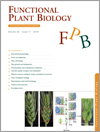Ver ítem
- xmlui.general.dspace_homeCentros e Institutos de InvestigaciónCIAP. Centro de Investigaciones AgropecuariasInstituto de Fisiología y Recursos Genéticos VegetalesArtículos científicosxmlui.ArtifactBrowser.ItemViewer.trail
- Inicio
- Centros e Institutos de Investigación
- CIAP. Centro de Investigaciones Agropecuarias
- Instituto de Fisiología y Recursos Genéticos Vegetales
- Artículos científicos
- Ver ítem
Interactions between soybean, Bradyrhizobium japonicum and Soybean mosaic virus: the effects depend on the interaction sequence
Resumen
The symbiotic interaction between soybean and nitrogen-fixing rhizobia can lead to plant growth promotion and induced systemic responses. Symbiotic interactions may increase tolerance/resistance to abiotic/biotic stress conditions, but are also sensitive to environmental conditions. Soybean mosaic virus (SMV), which is transmitted by seed and aphids, severely affects crop yields in many areas of the world, consequently virus infection may precede
[ver mas...]
The symbiotic interaction between soybean and nitrogen-fixing rhizobia can lead to plant growth promotion and induced systemic responses. Symbiotic interactions may increase tolerance/resistance to abiotic/biotic stress conditions, but are also sensitive to environmental conditions. Soybean mosaic virus (SMV), which is transmitted by seed and aphids, severely affects crop yields in many areas of the world, consequently virus infection may precede rhizobium infection or vice versa in the field. With the hypothesis that sequence of interaction is a key determinant of the resulting responses; growth, primary metabolism and defence responses were evaluated in different interaction sequences. Results showed that vegetative growth was promoted by Bradyrhizobium japonicum (Bj) inoculation and drastically impaired by SMV infection. The negative effect of SMV single infection on soybean growth parameters was correlated with photosynthesis decrease, sugar accumulation, oxidative damage, and increases in salicylic acid levels. Bj inoculation partially reversed virus-induced symptoms, mainly at Bj-SMV sequence. However, this symptom attenuation did not correlate with less virus accumulation. Nodulation was negatively affected by SMV, particularly when virus infection was previous to Bj inoculation (SMV-Bj). Defence related hormones (salicylic acid (SA)/jasmonic acid (JA)) and the expression of defence-related genes were dependent on the sequence of tripartite interaction. The present study showed that the sequence of the tripartite interaction among soybean, Bj and SMV determinates the tolerance/susceptibility to SMV infection, through changes in the defence mechanism and metabolic alteration.
[Cerrar]

Autor
Andreola, Sofia;
Rodriguez, Marianela;
Parola, Rodrigo;
Alemano, Sergio Gabriel;
Lascano, Hernan Ramiro;
Fuente
Functional Plant Biology 46 (11) : 1036-1048 (2019)
Fecha
2019-06-25
ISSN
1445-4408
1445-4416
1445-4416
Formato
pdf
Tipo de documento
artículo
Palabras Claves
Derechos de acceso
Restringido
 Excepto donde se diga explicitamente, este item se publica bajo la siguiente descripción: Creative Commons Attribution-NonCommercial-ShareAlike 2.5 Unported (CC BY-NC-SA 2.5)
Excepto donde se diga explicitamente, este item se publica bajo la siguiente descripción: Creative Commons Attribution-NonCommercial-ShareAlike 2.5 Unported (CC BY-NC-SA 2.5)

